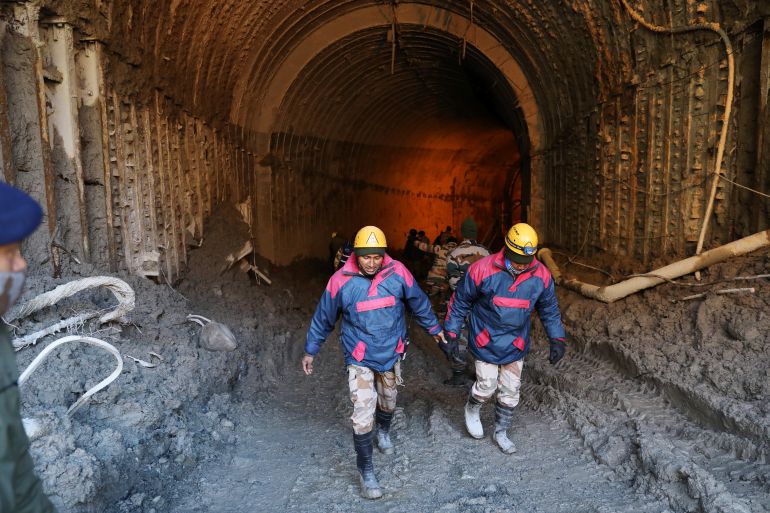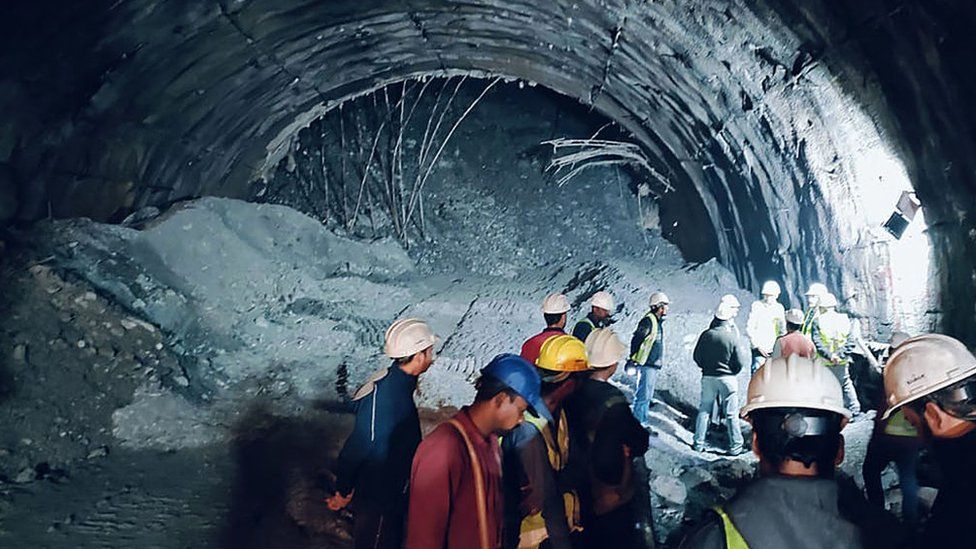Lucknow, India (AP) – In a race against time, rescue operations are underway in northern India to extricate 40 workers trapped for over two days beneath the debris of a collapsed tunnel in Uttarakhand. The incident occurred on Sunday in the mountainous state, known for its Hindu temples, as a part of the Chardham all-weather road project. With families anxiously awaiting news, authorities aim to free the workers within the next 24 hours.
The 2.5-foot-wide steel pipe, aided by hydraulic jacks, is a crucial element in the rescue strategy. Around 200 rescuers from federal and state disaster relief agencies are tirelessly working, deploying drilling equipment and excavators to reach the stranded workers. The collapsed section of the 4.5-kilometer tunnel, just 200 meters from the entrance, poses challenges, with falling debris impeding progress.
Despite the obstacles, officials express optimism, with Senior Government Official Ranjit Sinha assuring that all workers are alive. Through a pipeline, the rescue team has provided them with water and dry food. Families, concerned but hopeful, are closely following the developments, receiving reassurance from authorities and even direct communication with the trapped workers.
Lakshmi Pakhirai, mother of one of the workers, shared relief, “Someone in Uttarakhand called and told us that Souvik is fine. They said he is healthy and rescue workers have spoken to him.” This human touch amid the crisis provides solace to families awaiting the safe return of their loved ones.

The tunnel collapse, attributed to a landslide, emphasizes the risks associated with infrastructure development in regions prone to geological challenges. Most of the trapped workers are migrant laborers from various parts of the country, highlighting the diverse impact of such incidents on communities.
Uttarakhand, a popular pilgrimage destination, witnesses a continuous influx of visitors. The Chardham all-weather road project aims to enhance connectivity to Hindu pilgrimage sites, contributing to the region’s economic and spiritual significance. However, the recent tunnel collapse underscores the need for rigorous safety measures in such ambitious endeavors.
As the rescue operation enters its third day, coordination between federal and state agencies is paramount. The use of walkie-talkies and even written messages sent through the pipeline demonstrates the resourcefulness of the rescue teams in maintaining communication with the trapped workers.
In a crucial update, Col. Deepak Patil, former GM of the National Highways & Infrastructure Development Corporation Limited (NHIDCL), revealed the introduction of American-made “horizontal dry drilling equipment with auger.” This high-tech addition brings a renewed sense of optimism, with the machine making significant progress, reaching three meters inside the tunnel in just half an hour.

The operation faced setbacks on the previous day when an auger machine struggled to create a passage through the rubble. Despite local protests, the rescue plan remained focused on the “trenchless” technique, using 900 mm wide mild steel pipes to create a passage for workers to crawl through.
The situation has garnered attention at the highest levels of government, with Uttarakhand CM Pushkar Singh Dhami stating, “PM Modi is reviewing the rescue operation and is continuously in contact with all of us.” The collaborative efforts between the central and state governments underscore the urgency and gravity of the situation.
In conclusion, as the fifth day of the rescue operation unfolds, the use of advanced drilling equipment provides hope for a successful outcome. The perseverance of the rescue teams, coupled with the support from the central and state governments, reflects a unified commitment to saving lives. The incident serves as a poignant reminder of the challenges inherent in large-scale infrastructure projects and the importance of prioritizing safety in the pursuit of progress.

